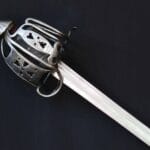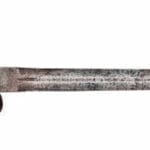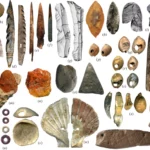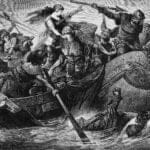Buckle up for a journey into the captivating world of dirk knives, a legacy forged in steel. These blades, steeped in Scottish heritage, have evolved from everyday tools to revered symbols of Highland culture. This review explores their fascinating history, cultural impact, and modern-day relevance.
The Dirk: More Than Just a Blade
The dirk knife evokes images of the rugged Scottish Highlands, fierce warriors, and a rich history. More than a mere weapon, it symbolizes a culture’s enduring spirit, a piece of art, and a testament to craftsmanship.
A History Etched in Steel
The dirk’s story likely began in 16th-century Scotland amidst clan warfare. Emerging from the ballock dagger, it became a practical weapon for close combat. The Highland Caterans, known for their fierce independence, adopted the dirk as a symbol of their identity. This period probably cemented the dirk’s place in Scottish history.
The Dirk Family: A Diverse Lineage
The dirk isn’t a single design but rather a family of blades. The classic Scottish dirk, often ornately carved and inlaid with precious materials, showcased the skills of craftsmen. The sgian dubh (pronounced “skee-an doo”), a smaller, concealed knife traditionally worn in the stocking, added another dimension to the Highland warrior’s arsenal. Today, modern bladesmiths continue this tradition, blending time-honored designs with modern materials.
A Living Symbol of Scottish Heritage
The dirk remains a powerful symbol of Scottish heritage, worn ceremonially by officers, pipers, and drummers in Scottish Highland regiments. Its presence at Highland Games and cultural events reinforces its connection to Scottish identity. Seeing a dirk displayed evokes a tangible link to generations past.
The Responsible Path to Ownership
Owning a dirk comes with responsibilities. Laws regarding ownership and carry vary by location. Researching your region’s specific regulations is crucial. Ethical considerations are also important. Today, the dirk should be treated with respect, acknowledging its cultural significance and avoiding irresponsible displays.
Preserving History: Caring for Your Dirk
For those interested in acquiring a dirk, specialized dealers offer antique originals and meticulously crafted reproductions. Proper care is essential to preserve these historical pieces, ensuring they can be admired for years to come.
The Dirk’s Enduring Legacy
The dirk’s story is etched in steel, a tale of warriors, craftsmen, and a resilient culture. From its humble beginnings to its current status as a symbol of heritage and pride, the dirk continues to fascinate. As long as its history, craftsmanship, and cultural significance are appreciated, its legacy will endure.
Anatomy of a Dirk: History, Design, and Modern Relevance
We’ve touched upon dirks, but let’s delve deeper. These aren’t ordinary pocketknives. Their rich history involves warriors, sailors, and much more. A dirk is a single-edged, sharp, pointy blade, optimized for piercing and thrusting. Its length typically ranges from 12 to 20 inches. Many dirks have a fuller, a groove that strengthens and lightens the blade.
Originating in the Scottish Highlands in the 16th century, dirks became ingrained in Scottish culture, serving as status symbols, tools, and integral parts of Highland identity. They were practical tools for sailors and others needing a sturdy blade. Over time, dirks evolved into ceremonial items, badges of honor for military officers, particularly in the navy. Today, they appear in traditional Scottish dress and formal ceremonies, linking the past to the present.
Historians debate the dirk’s precise origins and evolution, with some suggesting it evolved from earlier daggers while others propose it was a unique creation. This ongoing research adds to the mystique of this iconic blade. While less common today, dirks are prized by collectors for their historical value and craftsmanship. Modern versions, often crafted with high-quality materials, are also available. The dirk continues to capture the imagination.
| Feature | Description |
|---|---|
| Blade Type | Single-edged, optimized for thrusting and piercing |
| Length | Typically 12-20 inches, though variations exist |
| Fuller | A groove along the blade, enhancing strength and reducing weight (often present, but not always) |
| Origin | Scottish Highlands, 16th century |
| Historical Use | Weapon, tool, status symbol |
| Modern Use | Ceremonial item, collectible, some contemporary versions for practical use |
While we can describe typical dirk characteristics, variations exist. Not every historical dirk matches the description perfectly, and modern interpretations can deviate. This makes studying these knives so fascinating.
Dirk vs. Dagger: Unraveling the Subtle Differences (and Similarities)
We’ve discussed these pointy pieces of history, but let’s clarify the distinctions between a dagger and a dirk. It’s nuanced, as a dirk is a type of dagger, but not all daggers are dirks. Think of it like squares and rectangles.
Distinguishing them is easiest by examining the blade. A dirk, designed for thrusting, is generally a long, single-edged blade, typically 12-20 inches. Daggers can be single or double-edged and come in various lengths, often shorter than a dirk. Dirks are specialized thrusting tools, while daggers serve more general pointy-stabby purposes.
Handles can offer clues, though less definitively. Dirk handles vary in materials and shapes. Dagger handles may have crossguards, which are rare on dirks.
Dirks originated in 16th-century Scotland, likely as civilian self-defense weapons. They became associated with Highland culture—a sidearm, status symbol, and mark of clan affiliation. Daggers boast a longer, more global history, appearing in various forms across cultures as weapons, tools, and ceremonial objects.
This historical difference informs their cultural significance. Dirks are intertwined with Scottish heritage, appearing in traditional dress and formal ceremonies. They became popular with British naval officers during the Age of Sail. Daggers, with broader histories, hold varied cultural meanings—self-defense, assassination, rituals—depending on the time and place.
Today, dirks are mostly collector’s items, valued for history and craftsmanship. They’re displayed in museums, private collections, and homes. Daggers retain some practical applications in military, law enforcement, hunting, and self-defense. Carrying a dagger is subject to local laws.
| Feature | Dirk | Dagger |
|---|---|---|
| Blade Edge | Single | Single or Double |
| Blade Length | 12-20 inches | Varies, often shorter |
| Handle | Varies | Often with a crossguard |
| Historical Origin | 16th Century Scotland | Varies, widespread |
| Cultural Significance | Scottish Highland Culture | Varies widely |
| Modern Use | Primarily collector’s item | Some practical uses |
While generalizations can be made, exceptions exist. The world of edged weapons is full of unique examples. Safety is paramount—handle with care, respect laws, and admire responsibly.
Beyond the Fairbairn-Sykes: The Real Knives of the SAS
The Fairbairn-Sykes fighting knife, with its double-edged blade and distinctive handguard, is practically synonymous with the SAS. Designed in WWII for close-quarters combat, it remains iconic. However, it’s no longer the sole knife of the SAS.
Today, the SAS prioritizes adaptability, allowing operators to choose knives suited to their needs and fighting styles. Missions, environments, and personal preferences vary, requiring a flexible approach.
SAS soldiers often use the standard-issue British Army knife, valued for its durability and versatility. Beyond this, operators may customize their issued knives or select specialized blades for breaching, cutting ropes, or survival situations.
While the Fairbairn-Sykes remains historically significant, modern SAS knife usage is more diverse. This likely reflects evolving combat tactics and a focus on individual specialization. Some experts suggest this personalized approach provides a tactical advantage. Of course, specific knife usage details remain classified. However, available information suggests a shift from a single prescribed blade to an adaptable, operator-centric philosophy.
| Knife Type | Likely Use Cases | Potential Advantages |
|---|---|---|
| Fairbairn-Sykes | Ceremonial, historical context, some specialist roles | Iconic design, historical significance |
| Standard Issue Knife | General utility, everyday tasks | Durability, versatility, readily available |
| Specialized Knives | Breaching, rescue, specific mission requirements | Tailored to specific tasks, enhanced functionality |
Further research into military procurement and special forces equipment could reveal more, but much information remains classified.
Ding Dong Merrily on High Lyrics
- Unlock Water’s Symbolism: A Cross-Cultural Exploration - April 20, 2025
- Identify Black and White Snakes: Venomous or Harmless? - April 20, 2025
- Unlocking Potential: Origins High School’s NYC Story - April 20, 2025















1 thought on “The Dirk Knife: A Legacy Forged in Steel”
Comments are closed.